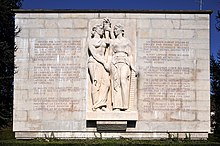Génissiat dam
| Génissiat dam | |||||
|---|---|---|---|---|---|
| View from the southwest | |||||
|
|||||
|
|
|||||
| Coordinates | 46 ° 3 '8 " N , 5 ° 48' 46" E | ||||
| Data on the structure | |||||
| Lock type: | Gravity dam | ||||
| Construction time: | 1937-1948 | ||||
| Height of the barrier structure : | 104 m | ||||
| Building volume: | 440 000 m³ | ||||
| Crown length: | 165 m | ||||
| Crown width: | 9 m | ||||
| Base width: | 57 m | ||||
| Power plant output: | 396 MW | ||||
| Operator: | Compagnie nationale du Rhône | ||||
| Data on the reservoir | |||||
| Reservoir length | 20 km | ||||
| Storage space | 53 000 000 m³ | ||||
The Génissiat dam is a gravity dam that dams the Rhone at Injoux-Génissiat , about 40 km below Lake Geneva , to form a narrow lake about 20 km in length. When it was completed in 1948, the power plant connected to it was the largest hydropower plant in Europe.
Technical information
The Génissiat dam is operated by the Compagnie nationale du Rhône (CNR). The dam wall consists of 440,000 cubic meters of concrete . It is 104 meters high and 165 meters long at the top. It is 57 meters thick at the bottom and 9 meters at the top. The dammed lake has a volume of 53 million cubic meters.
The run-of-river power plant at the foot of the dam has six units with vertical Francis turbines with a maximum output of 66 MW each. The electrical energy is increased to 220 kV and fed into the European power grid via facilities of the Électricité de France . The average annual energy production is 1.7 billion kWh.
Building history
As early as 1902, Léon Mähl had proposed building a hydroelectric power station near Génissiat to supply Paris with electricity. Construction work began in 1937 as the first power plant project by CNR, which was founded in 1933. Architects were Albert Laprade, Pierre Bourdeix, Jean Vernon and Bruno Philippe. The construction of the dam was carried out by a company consortium that was set up specifically for this purpose. By the spring of 1939, two underground canals had been completed that led the Rhône out of its bed over a length of 600 meters. This was necessary so that the foundations of the dam could be laid. During the occupation of France in World War II, the construction site was flooded and construction work was suspended. Until the liberation, the construction site was a local resistance center in the region. Construction work resumed in the summer of 1945. In the summer of 1946, 3,000 workers were working and building 300,000 cubic meters of concrete. The dam wall was completed at the end of 1947 and the lake on 19/20. January 1948 filled with water within only 36 hours. The power station was connected to Paris and Lyon by high voltage lines . On March 19, 1948, it fed electricity for the first time. At the official inauguration on August 1, 1948, the French President Vincent Auriol called the building the French Niagara and named it an example of the reconstruction of France .


